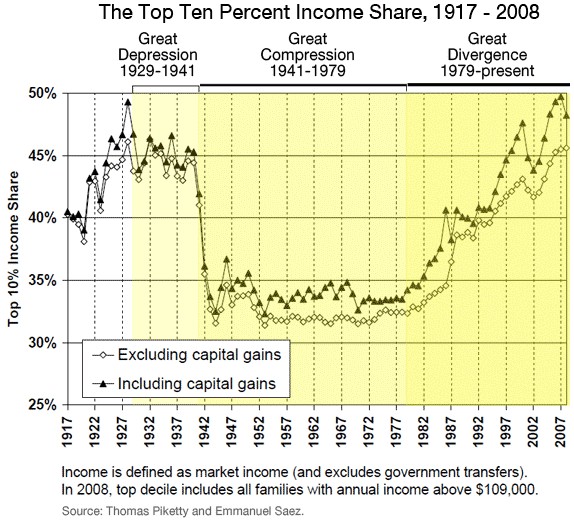Plutarch, writing almost 2,000 years ago, told us that “an imbalance between rich and poor is the oldest and most fatal ailment of all republics.”
Below is a chart that shows the course of income imbalance over the last 93 years in the U.S. If it showed the course of net worth imbalance, it would be much more dramatic. If it showed data for the top tenth of one percent– not just the top ten percent– it would be extraordinarily dramatic.
Inter alia, the chart shows that both the Great Depression of the ’30s and the present crisis were immediately preceded by great buildups in inequality. When ordinary people lack the wealth to buy things– houses for example–the system crashes.
There’s also a lot of data that show that economic equality conduces, quite literally, to the health of society. The correlation between equality and most measures of well-being is stronger than the correlation between wealth and well-being. See Richard G. Wilkinson & Kate Pickett, The Spirit Level (2009). For a good review of that book, see David Runciman in the London Review of Books, Oct. 22, 2009, .
Still, the rich consistently try to destroy egalitarianism, because for their segment, inequality is fine. It means increasingly desperate people trying increasingly hard to serve the rich. The rich also try to destroy the political means by which the rest of society might seek relief, which is exactly Plutarch’s point. Witness the rise of the present-day Tea Parties. A recent article in the New Yorker describes how the Koch brothers– Texas billionaires– have lavishly financed that movement.
In 1980 Ronald Reagan managed to break the egalitarian consensus that had held since FDR. (See the chart.) The key was playing on racial divisions. Reagan’s first campaign speech was in Philadelphia, Misssissippi. That town is famous for one thing only. It’s where three civil rights workers were lynched and murdered in the 1960s. Reagan’s target audience didn’t miss his message. Social justice was cast in terms of giveaways to demonized blacks– mythologized welfare queens in Cadillacs. Reagan’s ascendancy, by his exploitation of the race issue, is described by Thomas B. & Mary D. Edsall in Chain Reaction (1992). Thomas Edsall, until his retirement, was a reporter for the Washington Post.
The U.S. is now more unequal than a number of countries in Latin America. When I was younger it was accepted wisdom that those countries would never get anywhere until they solved the inequality problem.
John Hellegers




 © 2025 All Rights Reserved
© 2025 All Rights Reserved